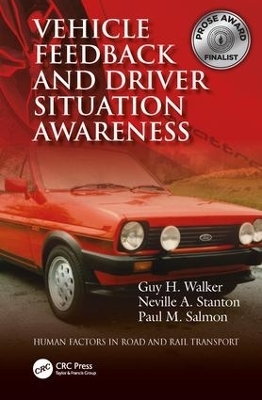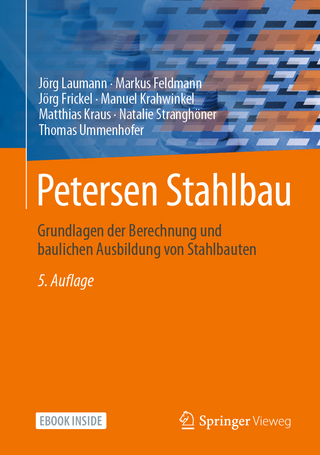
Vehicle Feedback and Driver Situation Awareness
CRC Press (Verlag)
978-1-4724-2658-1 (ISBN)
Association of American Publishers (AAP) Finalist for the 2019 PROSE Award
Features
Diagnosis of how vehicle feel impacts driver situation awareness, and how this could aid future vehicle designs
Multi-theory approach to driver situation awareness, and how different views of this important concept give rise to different insights
Comprehensive analysis of situation awareness in driving, the information requirements of drivers, and how these needs can be supported
Practical descriptions of how state-of-science Human Factors methods have been applied in practice
Dr Guy Walker is an Associate Professor within the Centre for Sustainable Road Freight at Heriot-Watt University in Edinburgh. He lectures on transportation engineering and human factors and is the author/co-author of over one hundred peer reviewed journal articles and thirteen books. He has been awarded the Institute for Ergonomics and Human Factors (IEHF) President’s Medal for the practical application of Ergonomics theory and Heriot-Watt’s Graduate’s Prize for inspirational teaching. Dr Walker has a BSc Honours degree in Psychology from the University of Southampton, a PhD in Human Factors from Brunel University, is a Fellow of the Higher Education Academy, and a member of the Royal Society of Edinburgh’s Young Academy of Scotland. His research has featured in the popular media, from national newspapers, TV and radio through to an appearance on the Discovery Channel. He has previously owned a Suzuki SC100 Whizzkid, two MkI Ford Fiesta XR2’s, two Suzuki TL1000R superbikes, and currently drives an Audi S1. Professor Neville A. Stanton is a Charted Psychologist, Chartered Ergonomist and Chartered Engineer and holds a Chair in Human Factors Engineering in the Faculty of Engineering and the Environment at the University of Southampton. He has published over 300 peer-reviewed journal papers and 40 books on human factors and ergonomics. In 1998, he was awarded the Institution of Electrical Engineers Divisional Premium Award for a co-authored paper on engineering psychology and system safety. The Institute for Ergonomics and Human Factors awarded him the Sir Frederic Bartlett medal in 2012, the President’s Medal in 2008 and the Otto Edholm medal in 2001 for his original contribution to basic and applied ergonomics research. In 2007, the Royal Aeronautical Society awarded him the Hodgson Medal and Bronze Award, with colleagues, for their work on flight deck safety. He is also the recipient of the Vice Chancellor’s Award for postgraduate research supervisor of the year in the Faculty of Engineering and the Environment at the University of Southampton. Professor Stanton is an associate editor of the IEEE Transactions on Human Machine Systems and is on the editorial board of Theoretical Issues in Ergonomics Science. Professor Stanton is a Fellow and Chartered Occupational Psychologist registered with the British Psychological Society, a Fellow and Chartered Ergonomist registered with the Institute of Ergonomics and Human Factors Society, and a Chartered Engineer registered with the Institution of Engineering and Technology. He has a BSc in Occupational Psychology from the University of Hull, an MPhil in Applied Psychology, a PhD in Human Factors Engineering from Aston University in Birmingham, and a DSc in Human Factors Engineering awarded by the University of Southampton. He has previously owned a 1978 Mini 1000, a Mark 1 Ford Escort, a Saab 900, a Yamaha FS1E, a Honda 400/4, a Honda CB750K, and a Honda CBR1100XX Super Blackbird. He now owns a Toyota Landcruiser, Mazda MX5 and Triumph Bonneville T100. Paul Salmon is a Professor in Human Factors and leader of the USCAR (University of the Sunshine Coast Accident Research) team at the University of the Sunshine Coast. He holds an Australian Research Council Future Fellowship in the area of road safety and has over 13 years’ experience in applied human factors research in a number of domains, including military, aviation, road and rail transport. Paul has co-authored 10 books, over 90 peer review journal articles, and numerous conference articles and book chapters. Paul has received various accolades for his research to date, including the 2007 Royal Aeronautical Society Hodgson Prize for best paper and the 2008 Ergonomics Society’s President’s Medal. Paul was also recently named as one of three finalists in the 2011 Scopus Young Australian Researcher of the Year Award. He has previously owned a Fiat Cinquecento Sporting, two MkIII Ford Escort Cabriolets, and currently drives a Jeep Wrangler…often on the beach.
Introduction. What’s Happened to Car Design? Feedback Properties of Vehicle Controls. Situation Awareness Requirement Analysis. The Ironies of Vehicle Feedback. Comparing Car Driver and Motorcyclist Situation Awareness. Cognitive Compatibility. Driver Training and Situation Awareness. Driver SA and the Future City. Conclusions. Appendix. Further Reading. References and Bibliography. Index.
| Erscheinungsdatum | 11.06.2018 |
|---|---|
| Reihe/Serie | Human Factors in Road and Rail Transport |
| Zusatzinfo | 34 Tables, black and white; 67 Illustrations, black and white |
| Verlagsort | London |
| Sprache | englisch |
| Maße | 156 x 234 mm |
| Gewicht | 706 g |
| Themenwelt | Technik ► Bauwesen |
| Technik ► Fahrzeugbau / Schiffbau | |
| Technik ► Umwelttechnik / Biotechnologie | |
| ISBN-10 | 1-4724-2658-4 / 1472426584 |
| ISBN-13 | 978-1-4724-2658-1 / 9781472426581 |
| Zustand | Neuware |
| Informationen gemäß Produktsicherheitsverordnung (GPSR) | |
| Haben Sie eine Frage zum Produkt? |
aus dem Bereich


